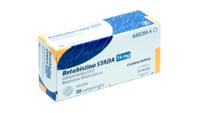

Betahistina stada 16 mg comprimidos efg


How to use Betahistina stada 16 mg comprimidos efg
Introduction
Leaflet: information for the user
Betahistina Stada 16 mg tablets EFG
Dihydrochloride of betahistina
Read this leaflet carefully before starting to take this medicine, because
it contains important information for you.
-Keep this leaflet, as you may need to read it again.
- If you have any doubts, consult your doctor, pharmacist or nurse.
- This medicine has been prescribed only for you, and you must not give it to other people
although they may have the same symptoms as you, as it may harm them.
- If you experience any side effects, consult your doctor or pharmacist, even if they are not listed
in this leaflet. See section 4.
1. What is Betahistina Stada and what it is used for
2. What you need to know before starting to take Betahistina Stada
3. How to take Betahistina Stada
4. Possible side effects
5. Storage of Betahistina Stada
6. Contents of the pack and additional information
1. What is Betahistina Stada and what is it used for
Betahistina belongs to a group of medications called antivertiginous drugs.
Betahistina is used for the treatment of Ménière's Syndrome, which is a disorder characterized by the following symptoms: vertigo (with nausea and vomiting), hearing loss, and a sensation of noise inside the ear (tinnitus).
The active ingredient of this medication is a histamine analogue that acts by improving circulation in the inner ear and thereby reducing pressure. The inner ear is one of the organs responsible for the sense of balance.
2. What you need to know before starting to take Betahistina Stada
Do not take Betahistina Stada
-if you are allergic to the active ingredient or to any of the other components of this medication (listed in section 6).
- if your doctor has told you that you have a certain type of adrenal gland cancer called pheochromocytoma.
Warnings and precautions
Consult your doctor or pharmacist before starting to take Betahistina Stada:
- if you have bronchial asthma
- if you have or have had stomach ulcers
- if you suffer from skin rashes and intense itching (urticaria), skin eruption (exanthema) or hay fever
- if you have low blood pressure
Other medications and Betahistina Stada
Inform your doctor or pharmacist if you are using, have used recently or may need to use any other medication.
The administration at the same time as betahistina with antiallergic medications such as antihistamines (especially H1 antagonists) may reduce the effectiveness of both medications.
Use of Betahistina Stada with food, drinks and alcohol
It is recommended to take betahistina during or after meals to avoid gastrointestinal discomfort.
Pregnancy, breastfeeding and fertility
If you are pregnant or breastfeeding, believe you may be pregnant or intend to become pregnant, consult your doctor or pharmacist before using this medication.
The effects of this medication on the fetus are unknown, so betahistina should not be taken during pregnancy, unless your doctor considers it necessary.
The effects of this medication on breast milk are unknown, so if you are taking betahistina, you should not breastfeed your child.
Driving and operating machinery
Betahistina is indicated for Meniere's syndrome. This disease may negatively affect the ability to drive and operate machinery. In clinical trials specifically designed to investigate the ability to drive or operate machinery, betahistina had no effects or were insignificant.
Betahistina Stada contains lactose
This medication contains lactose. If your doctor has told you that you have a certain sugar intolerance, consult with them before taking this medication.
3. How to Take Betahistina Stada
Follow exactly the administration instructions of this medication indicated by your doctor or pharmacist. In case of doubt, consult your doctor or pharmacist again.
Your doctor will adjust the dose based on your response to treatment from an initial dose of half a tablet of 16 mg three times a day to a tablet of 16 mg three times a day (maximum dose). The maintenance dose will be adjusted based on your response, with the minimum effective dose being half a tablet of 16 mg three times a day.
In some cases, improvement may not become apparent until two weeks after starting treatment. The optimal result is obtained after several months of treatment.
The tablets should be taken with water. The tablets can be taken with or without food. However, if you take them without food, they may cause mild stomach problems (listed in section 4). Taking the tablets with food may help reduce stomach problems.
The tablet can be divided into equal doses.
Use in children and adolescents
Betahistina is not recommended for use in children and adolescents under 18 years due to the scarcity of data on safety and efficacy.
If you take more Betahistina Stada than you should
In case of overdose or accidental ingestion, consult your doctor or pharmacist immediately, or call the Toxicological Information Service, phone: 91 562 04 20, indicating the medication and the amount ingested. It is recommended to bring the packaging and the medication leaflet to the healthcare professional.
You may experience the following symptoms due to an overdose: nausea, drowsiness, abdominal pain. You may also experience rapid heart rate (tachycardia), low blood pressure (hypotension), difficulty breathing with a sensation of choking (bronchospasm), fluid accumulation in tissues (edema). Seizures may occur after taking very high doses.
It is recommended to provide symptomatic treatment since there is no specific antidote.
If you forgot to take Betahistina Stada
Do not take a double dose to compensate for the missed doses. If you forget to take a dose, wait until the next scheduled dose and continue with the normal treatment.
If you interrupt the treatment with Betahistina Stada
You should take betahistina for as long as your doctor recommends. Do not interrupt the treatment prematurely, as you will not achieve the expected results.
If you have any other questions about the use of this medication, ask your doctor, pharmacist, or nurse.
4. Possible Adverse Effects
Like all medications, this medication may produce adverse effects, although not all people may experience them.
The classification by frequencies is as follows:
Very frequent: may affect more than 1 in 10 people
Frequent: may affect up to 1 in 10 people
Infrequent: may affect up to 1 in 100 people
Rare: may affect up to 1 in 1,000 people
Very rare: may affect up to 1 in 10,000 people
Frequency not known: the frequency cannot be estimated from the available data
In clinical trials, the adverse effects found were:
Gastrointestinal disorders
Frequent: nausea and dyspepsia (upper abdominal discomfort with a feeling of bloating).
Nervous system disorders
Frequent: headache
After its commercialization and in scientific literature, the following adverse effects with an unknown frequency have been referred to:
Immune system disorders
Hypersensitivity reactions, for example anaphylaxis.
Gastrointestinal disorders
Mild gastric discomfort (for example vomiting, gastrointestinal pain, distension, and abdominal bloating). These effects can usually be treated by taking the medication during meals or reducing the dose.
Skin and subcutaneous tissue disorders
Hypersensitivity skin and subcutaneous reactions, particularly angioneurotic edema (skin and mucous membrane swelling, especially on the face, mouth, tongue, and hands), urticaria, skin rash, and pruritus.
Reporting Adverse Effects:
If you experience any type of adverse effects, consult your doctor or pharmacist, even if they are possible adverse effects not listed in this prospectus. You can also report them directly through the Spanish System for Pharmacovigilance of Medicinal Products for Human Use:https://www.notificaram.es. By reporting adverse effects, you can contribute to providing more information on the safety of this medication.
5. Conservation of Betahistina Stada
Keep this medication out of the sight and reach of children.
Do not store at a temperature above 30°C.
Do not use this medication after the expiration date that appears on the packaging after CAD. The expiration date is the last day of the month indicated.
Medicines should not be disposed of through drains or in the trash. Dispose of packaging and medications you no longer need at the SIGRE collection point at the pharmacy. Ask your pharmacist how to dispose of packaging and medications you no longer need. By doing so, you will help protect the environment.
6. Content of the packaging and additional information
Composition of Betahistina Stada:
- The active ingredient is dihydrochloride of betahistina. Each tablet contains 16 mg of dihydrochloride of betahistina.
- The other components (excipients) are lactose monohydrate, microcrystalline cellulose (E-460i), povidone (E-1201), anhydrous colloidal silica, crospovidone, stearic acid, and talc.
Appearance of the product and content of the packaging
Betahistina STADA is presented in the form of round white tablets with a groove on one face and “K” on the other.
Each package contains 30 tablets.
Holder of the marketing authorization and responsible for manufacturing
Holder
STADA Laboratory, S.L.
Frederic Mompou, 5
08960 Sant Just Desvern
(Barcelona)
Spain
Responsible for manufacturing
Kern Pharma, S.L.
Colón II Industrial Estate
Venus 72 Street
08228 Terrassa (Barcelona)
Spain
Last review date of this prospectus:August 2021
The detailed and updated information of this medication is available on the website of the Spanish Agency for Medicines and Medical Devices (AEMPS)http://www.aemps.gob.es/.

How much does Betahistina stada 16 mg comprimidos efg cost in Spain ( 2025)?
The average price of Betahistina stada 16 mg comprimidos efg in August, 2025 is around 2.73 EUR. Prices may vary depending on the region, pharmacy, and whether a prescription is required. Always check with a local pharmacy or online source for the most accurate information.
- Country of registration
- Average pharmacy price2.73 EUR
- Active substance
- Prescription requiredYes
- Manufacturer
- CompositionLactosa monohidrato (140,00 mg mg)
- This information is for reference only and does not constitute medical advice. Always consult a licensed doctor before taking any medication. Oladoctor is not responsible for medical decisions based on this content.
Ask a doctor about Betahistina stada 16 mg comprimidos efg online
Talk to a doctor online
Need help understanding this medicine or your symptoms? Online doctors can answer your questions and offer guidance.















